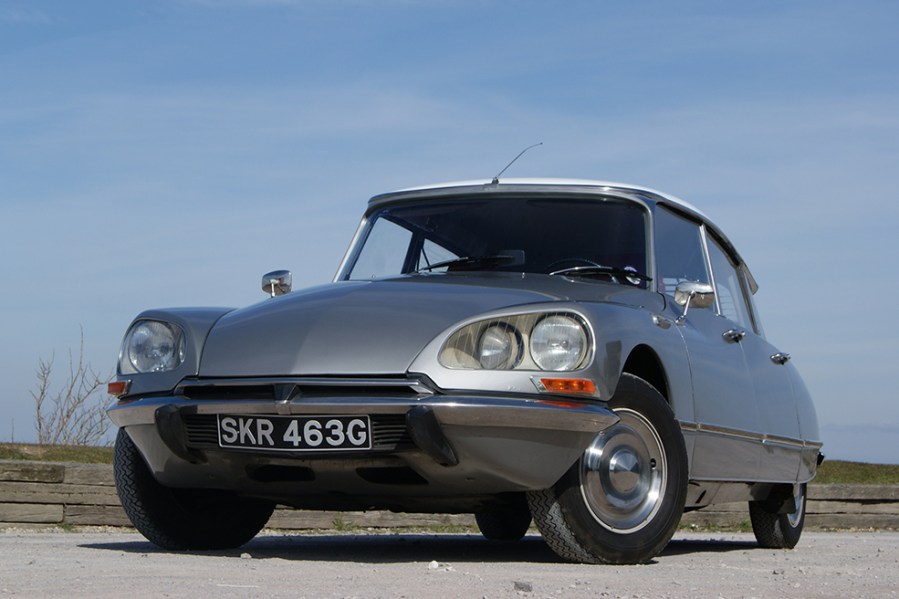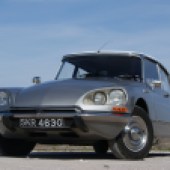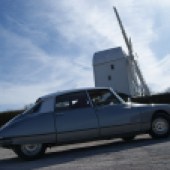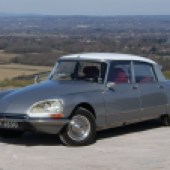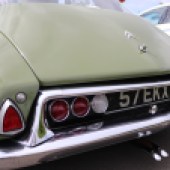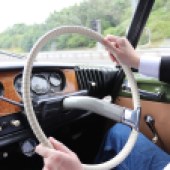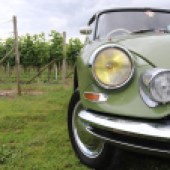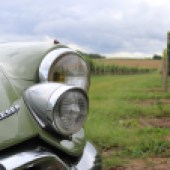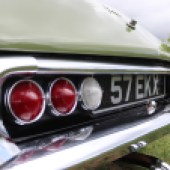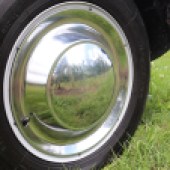The Citroën DS has been highly desirable since the moment it was launched – but there are oddball design features and pitfalls to watch out for
Words: Sam Skelton
It’s almost impossible to imagine just how but a stir the Citroën DS caused at its launch in 1955. Suffice it to say that any impressive news in the motor industry today would pale into insignificance were any manufacturer to announce a sea change of quite such magnitude. When your forefathers were still motoring around in Hillman Minxes or sidecars, along came this vision of the future which rode as if it was floating and looked like it had come straight out of ‘The Day The Earth Stood Still’. Styled by sculptor Flaminio Bertoni, the DS and its ID sister lasted a full twenty years in production, and were still ahead of the competition by the time the CX replaced them.
Built in Slough from 1956 to 1966, English IDs featured walnut dashboards and some trim from the Citroën DS. DSs were built in the UK too, alongside a new model called the DW which mated DS trim to the ID’s manual gearbox several years before Paris had the same idea.
It wasn’t all new – under the bonnet was a different story since the flat six originally intended needed money Citroën didn’t have, so in went the four-pot from the Traction Avant. Citroën saved its money for the hydraulics, which on top spec cars covered not only the revolutionary suspension but the brakes, steering, and even the clutch action in the semi-automatic transmission. For those for whom the Citroën DS was too expensive, there was also the ID – same body, same suspension, but less power and less toys, no powered steering, brakes or clutch.
Bigger engines and specification upgrades over the course of two decades kept the car relevant, while the commodious estate (badged Safari in the UK and under a wide variety of different names abroad) seated seven with space for luggage. Beloved of antiques dealers for the self-levelling suspension, the Safari survives in relatively small numbers today.
For 1962 there was a light facelift, while a more comprehensive redesign for 1967 gave the Citroën DS and ID the directional headlamps for which they’re so well known today. 1970 saw the end of ID production in favour of the D Special and D Super. In 1974 these lower-spec models were replaced by the CX while the top-level DS Pallas survived until 1975.

Bodywork
The shell of a DS is similar to that of a Rover P6, in that all the panels hang from an internal structural frame. As such, how it looks on the outside really isn’t the biggest issue, it’s what’s underneath that matters. First thing to do is remove the rear wings to assess the condition underneath: It’s one bolt each and can be done with the wheelbrace as they have to come off to change a rear wheel. If the owner’s reluctant, alarm bells should ring.
Sills and boot floors can rust, so check thoroughly for any crusting or swelling – the latter area supports the trailing arm mounts, so check thoroughly for damage here. Likewise roof gutters are a known weak spot – the glass fibre roof was bonded on from 1972, but on all cars it rubs against the paint in the gutters and when water subsequently gets trapped it corrodes the gutters from the inside. It’s a screen out and roof off repair, and the easiest test is to run your finger along the area behind the front screen seal. It’s not cost effective to repair unless the car is cheap. Push the top of the screen – if that isn’t solid, then you’re looking at a four-figure bill.
Early cars have the most spot welds, making them likely to be the best survivors. Front suspension mountings can crack around the wishbone carrier bolts, which can sound like a twig snapping under cornering. Repairs can be anything from £200 to £2000 depending upon how badly they’ve gone. Finally, don’t worry about pitted chrome – apart from the Pallas boot hinges and the door handles, all the brightwork is stainless steel. It won’t rust, but careless handling can cause damage.

Engine and transmission
All DSs and IDs came with engines of the same family, in a choice of three sizes and multiple states of tune. The engine had started live in 1934 in the Traction Avant and was lightly modernised with a hemi head and improved manifolds for the DS. Starting in 1911cc form, it expanded to 2175cc and then 2347cc. Both the 2.1 and 2.3 were also available with electronic fuel injection. They’re generally reliable engines and capable of doing up to a quarter of a million miles, but there have been a few rough engines over time that require 50,000 mile rebuilds.
The compression should be between 120 and 140psi on each cylinder, so check this if you can. Oil leaks around the base of the distributor can be camshaft seals, and these require the separation of engine and transmission to fit. Noisy tappets could either mean valves need adjusting or that the cam and followers are worn, so if in doubt have an expert check it. On fuel-injected engines the air intake needs removing to access the tappets. Timing chains can stretch, so check play by moving the main pulley. If there’s play it’s an engine out job to replace the chain.
Big end failure is most common on the 2.3 – the smaller the engine the more reliable it’s likely to be in service.
There are, broadly, two types of transmission available on DS and ID models. There’s a standard manual, with the option of four or five gears dependent upon specification and model year, and then there is the BVH ‘clutchless’ semi-automatic system many associate with the DS model.
In truth, this is a rarer transmission and it can be more complicated. Internal leaks can lead to the car jumping out of second or third, while a sticking valve in the clutch selector can impact upon selection of first and reverse.
The clutch selector plate atop the gearbox can leak, causing contamination of the gear oil with LHM. Check thoroughly for leaks, and also check the transmission fluid regularly to ensure it’s not been contaminated.

Suspension, steering and brakes
The suspension system is one of the D-Series’ main attractions, though many who lack experience with Citroën will write it off as being overly complicated. It really isn’t – especially in the case of the ID, which lacks high pressure braking and powered steering and so has a hydraulic system entirely devoted to its suspension. Check it rises and lowers from each height, and listen for a regular tick from the hydraulic pump every thirty seconds. Any more frequently and there could be a leak, so have the car checked over.
In standard height, push each corner down in turn. It should sink willingly and rise softly, very unlike a coil-sprung car. If it’s firm that could indicate the need for new spheres. Be careful to use the slam panel for this test and not the wings at the front, as they can dent. Sphere changes are advised every five years or so, but it’s not a hard and fast rule.
Until 1967 Citroen used LHS fluid, which is red, and black-painted spheres. After 1967 LHM (green fluid) was used, and the spheres colour-coded green for ease. Most cars will have been converted to run LHM by now, but double check the correct fluid for the car. LHM is the easier of the two to source.
There are two braking systems for these cars – that used on the DS and that used on the ID – though all Safaris, while strictly IDs, used the DS braking system.
Early IDs used an orthodox braking system with a conventional master cylinder. Later models used the same high-pressure setup as was found on the more luxurious DS, which utilised the same hydraulic system as the suspension. In both cases inboard discs were used at the front with hub-mounted drums at the rear , though the system in the DS was more effective. Not all cars used the mushroom-shaped button for brakes; British cars had mushrooms on all specifications, but left-hand drive IDs used a conventional pedal.

Interior and trim
Everything is available, at a cost, regardless of colour or trim. Many IDs and lower spec DSs have been upgraded to Pallas spec, given that it’s a simple upgrade and people want the more upmarket trim.
There’s far more interest value in cars with original trim these days, especially if they’re low specification IDs. Don’t worry too much about damage to cloth given the ease of replacement, but do make sure the carpets are dry and that there’s no water ingress through the screen and window seals.
While our guide is focused upon saloons and not the hugely valuable Decapotable convertibles, if you’re looking at a true Decapotable or a conversion it’s essential to check the condition of the hood.

Citroën DS: our verdict
For a long time, people have been put off buying the DS or ID models under fears of their complexity, and most have changed hands within the Citroën scene as a result. But there are scores of specialists and while these cars were complex by the standards of their era over 65 years on there’s little on the average D-Series that’s beyond the abilities of the average competent mechanic.
The Citroën Car Club is full of experts and enthusiasm, and we would advise you join the club before making your prospective purchase. There will be people in your local area happy to help you with your purchase and advise you on future maintenance. We wouldn’t advise anyone to buy a DS without an expert eye unless they were experienced with these cars.
Our advice would be to buy a late ID, something like a D Special or a D Super – ideally a D Super 5 with the five-speed gearbox. They offer exceptional value compared with cars like the Pallas models, which are desired beyond their true value when compared with other examples. Slough-built cars are equally prized, and have the added bonus of being right hand drive as well as being built in Britain. Best value are the left-hand drive models imported from mainland Europe, as many prefer sitting on the right-hand side of the car.

